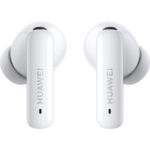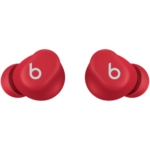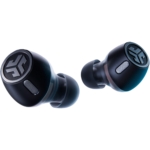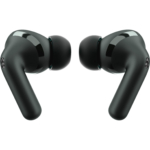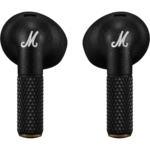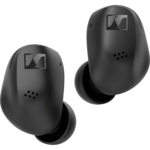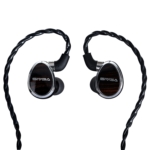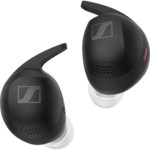Razer has presented an interesting gaming headset with the Barracuda X, which is a welcome change from the over-engineered gaming headsets thanks to its minimalist exterior. If a light weight, good wearing comfort, a stress-free setup and, last but not least, good sound (except for the above-mentioned limitations) are at the top of your wish list, you should be happy with the Barracuda X.
With the Barracuda X, Razer brings a one-fits-all solution to the table: thanks to mini-USB-C wireless transmitters, the Barracuda X is supposed to excel with PCs, Playstations, Switches as well as Android devices. We tried it out.
Package & Appearance
These headphones come securely packaged in Razer’s signature green and black outer box. Inside is an approx. 130 cm long 3.5 mm jack cable with an angled plug on one side and corrosion-preventing gold-plated plugs on both sides. There is also an approx. 150 cm long USB-A to USB-C cable and an equally long USB-A to USB-C extension cable with a socket. A small wireless transmitter (approx. 37 mm x 13 mm x 6 mm) with a USB-C connector, a plug-in gooseneck microphone, a quick-start guide and the obligatory Razer stickers round out the package.
Design, workmanship and feel
The Razer Barracuda X are a pair of circumaural, closed headphones that are completely finished in matte black. Only the discreet manufacturer logo on the ear cups and the company name on the headband hint at their origins. The design is strongly reminiscent of the company’s Opus, the Barracuda X also appears contemporary and “sleek” in its design and lines. The headband is made of soft protein leather, the removable ear pads are made of a breathable mesh fabric (called FlowKnit), and the filling is memory foam for pleasant pressure distribution. The choice of materials for these over-ears could be of higher quality for my taste, but there is nothing to complain about in terms of workmanship. The black surface of the components was not very grease-sensitive in the test, although fingerprints are noticeable as light shadows.
Technology
The Barracuda X has a dynamic 40-millimetre driver on each side, called “TriForce” by Razer, which covers frequencies from 20 to 20,000 Hz. With an impedance of 32 ohms, this predator still has enough bite to play properly, even on mobile and smart devices via a mini-jack cable. With a stated peak sound pressure level of 96 dB SPL, the Barracuda X may not be one of the loudest fish in the pond, but it still delivers levels without distortion.
For connection, Razer rely on wireless instead of Bluetooth. The advantage of this 2.4 GHz wireless technology, which Razer calls “HyperSpeed Wireless”, is that the latency is lower than that of Bluetooth, and it is more stable.
The microphone, which plugs in via a mini-jack, works with a cardioid pick-up pattern, so it picks up sound primarily from the front. Its frequency spectrum is optimised for voice transmission with a bandwidth of 100 Hz to 10 kHz.
A multi-coloured LED on the left ear cup indicates the battery charge level. With up to 20 hours of battery life, the headphones last long enough. What’s more, the Barracuda X is 7.1 surround sound compatible (Windows 10 64-bit only), and if you want to upgrade to THX Spatial Audio, you will receive a promo code with a 50 per cent discount after registering the headphones with the manufacturer.
Handling
The Barracuda X has swivel and tilt ear cups, but it does not fold up. The size adjustment of the headband offers adjustment travel of approx. 3.5 centimetres and is graduated in nine steps. When the headphones are put on, the ear cups adapt effortlessly to the shape of the head, but there is “only” 6×4 cm of space under the pads, so it could be tight for large ears. With a net weight of about 255 grams, the wireless Barracuda X is comparatively light. The padded headband distributes the weight very well. Its contact pressure is more in the middle range, and it can slip off the head during faster head movements.
Controlling the Barracuda X is quick and easy: a volume control is centrally located on the left ear cup, but on our test model, it scratched the housing and had a slight left-right offset at the quietest setting. This is hardly noticeable in practice unless you want to listen extremely quietly at night. But even then, simply turn up the slider and lower the output volume of your external player.
Other controls are the mute switch for the microphone above the black wheel and the button for switching the predator on and off below it.
Sound
Once the small wireless transmitter is connected to a free USB-C port or via the adapter cable, the low-latency gaming can begin. This works within a few seconds without installing any drivers. However, the prerequisite for this is that the USB-C port on your tablet or smartphone also supports USB audio. Both an iPad Pro and a Pixel 3a had no problems in this regard. However, we were unable to check whether the whole thing also works via a corresponding Lightning-to-USB-C adapter on “regular” iPhones due to the lack of suitable plugs.
But back to the sound: the bass range pushes sub-basses into the ear in a rich but not-exaggerated way and will please those who like to bathe in voluminous battles. But when listening to modern styles such as EDM or urban music, the Barracuda X also shows that it can easily swim along. The mid-range builds on the bass with presence, so that not only the dialogue in games, but also vocals or podcasts are always brought out very clearly.
The highs finally put the overall picture together quite successfully. They deliver a top-end that is just airy enough for all important signal information to be audible. Fortunately, nothing hisses, neither with “spikily” mixed songs nor with spoken content.
For closed headphones, the stereo impression was good; events could be tracked relatively precisely, which is, of course, essential in games. On the other hand, the depth gradation was not as pronounced as I would have liked. With many pieces of music, but also with games, there was, unfortunately, no distinct three-dimensional sound field in my head; it was distributed more in the horizontal than the vertical plane.
A direct sound comparison between wireless and mini-jack is unfortunately not that easy due to the volume jumps when plugging them in, yet the wired version seemed to me to be a touch tighter and more compact.
As a pure stereo headset, this headset is, of course, still capable of virtual surround sound – but this only applies to Windows 10 operating systems in the 64-bit version. With supported games or films, you hear a much greater spatiality with correspondingly localisable events. Here, however, it behaves as expected: virtual 3D rooms are only poorly comparable with a real surround system based on speakers.
Microphone
To communicate with teammates, the first step is to plug in the included microphone to the headset; a foam pop shield softens plosive sounds and keeps things quiet in slightly windy conditions. Razer calls its microphone development “HyperClear Cardioid Mic” and wants to show that even your own voice can sound clear. But no matter how much we chatted, recorded and played – our voice was never hyper-clear. A bit muffled, but – thanks to the cardioid characteristic – well protected against interference from behind and the sides.
Technical specifications
- Ear couplingOver-ear
- Typeclosed
- Transducer principledynamic
- Frequency response (headphones)20 - 20.000 Hz
- Impedance32 ohms
- Sound pressure level (SPL)@ 1 kHz/1 mW: 97 dB
- Weight without cable255 g
- Cable length150 cm
What's in the box
- Detachable microphone
- USB-C wireless transmitter
- USB-C charging cable
- USB-A to -C adapter cable
- Mini jack cable












